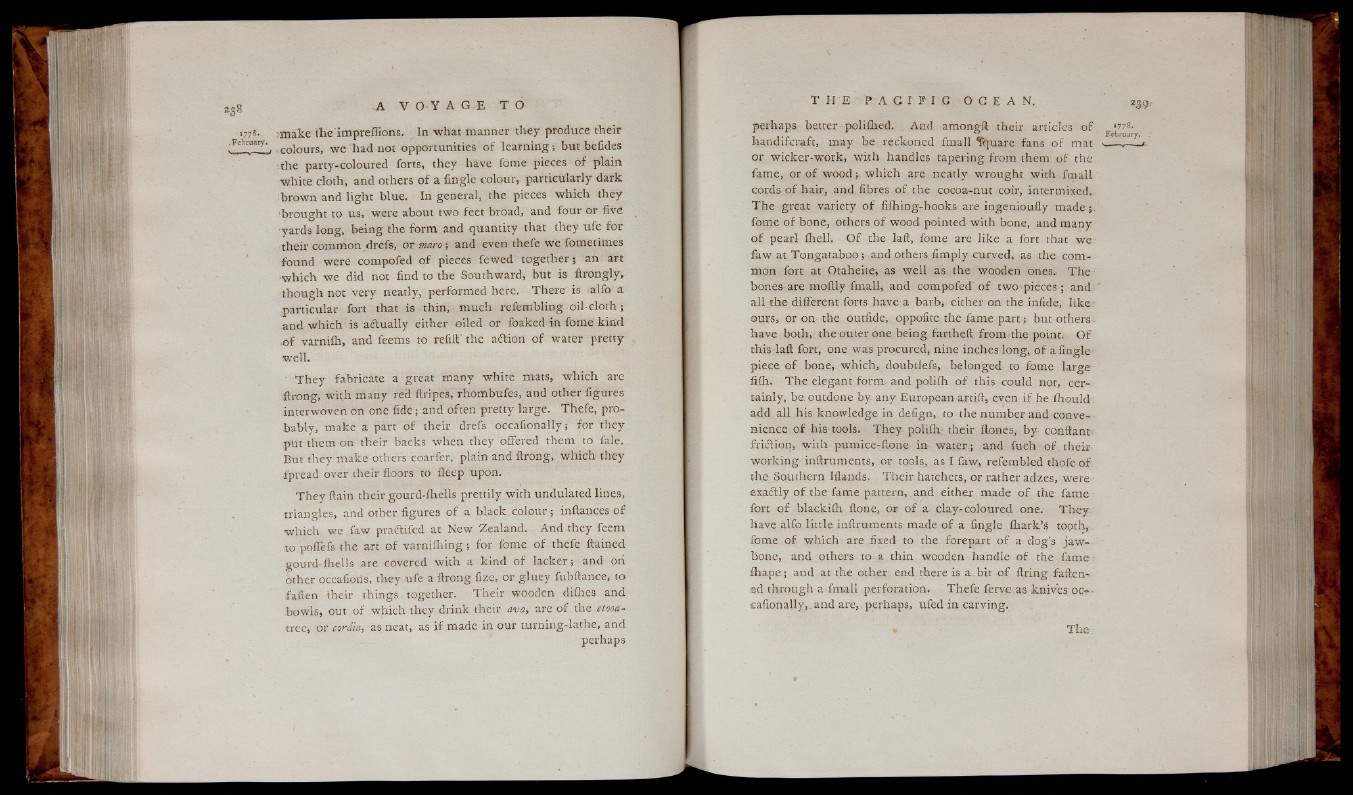
rmake ihe'impreiEons. In what manner they produce their
colours, w e had not opportunities o f lea rn in g ; but befides
the party-coloured forts, they have fome pieces o f plain
white cloth, and others o f a fingle colour, particularly dark
brown and ligh t blue. In general, the pieces w hich they
b rought to us, were about two feet broad, and fo u r or five
■yards long, b e in g the form and quantity that they ufe fo r
their common drefs, or maro ; and even thefe we fometimes
found were compofed o f pieces fewed to g e th e r ; an art
w h ich w e did not find to the Southward, but is ilron gly,
though not very neatly, performed here. There is alfo a
particular fort that is thin, much refembling oil-cloth;
and which is a flu a lly either oiled or foaked in fome kind
„of varnifh, and feems to refill;' the action o f water pretty
w ell.
T h e y fabricate a great many white mats, w h ich are
ftrong, with many red ftripes, rhombufes, and other figures
interwoven on one fide; and often pretty large. Thefe, probably,
make a part o f their drefs o cca fion ally ; fo r they
put them on their backs when they offered them to fale.
But they make others coarfer, plain and ftrong, w hich they
¿bread over their floors to fleep upon.
T h e y ftain their gourd-fhells prettily with undulated lines,
triangles, and other figures o f a bla ck c o lo u r ; inftances o f
w h ich we .faw praftifed at New Zealand. And they feem
to pofiefs the art o f varniihing ; for fome o f thefe ftained
gourd-ihells are covered w ith a kind o f la c k e r ; and on
other occafioris, they ufe a ftrong fize, or g lu e y fubftance, to
fatten their things together. T h e ir wooden diihes and
bowls, out o f which they drink their ava, are o f the etooa-
tree, or cordia, as neat, as i f made in our turning-lathe, and
perhaps
perhaps better poliihed. , And amongft their articles o f E*778-
handifcraft, may be reckoned fmall Tquare fans o f mat
or wicke r-wo rk, w ith handles tapering from them o f the
fame, or o f w o o d ; whi'ch are neatly w rought with fmall
cords o f hair, and fibres o f the cocoa-nut coir, intermixed..
T h e great variety o f fifhing-hooks are ingenioufly made ;.
fome o f bone, others o f wood pointed with bone, and many
o f pearl ihell. O f the laft, fome are lik e a fort that we
faw at Tong atab oo; and others fimply curved, as the common
fort at Otaheite, as w e ll as the wooden ones- T he
bones are moftly fmall, and compofed’ o f two pieces ; and '
a ll the different forts have a barb; either on the infide, lik e ;
©urs, or on the outfide; oppofite the fame part ; but others 1
have both, the outer one being fartheft from the point. O f
this laft fort, one was procured; nine inches long; o f a fingle
piece o f bone, which, doubtlefs, belonged to fome large-
iifti. T h e elegant form; and poliih o f this could nor, certainly,
b e outdone by any European artift, even i f he ihould ;
add all his knowledge in defign, to the number and convenience
o f his tools. T h e y poliih- their ftones, by conftant
fri& io q, w ith pumice-ftone in water ; and fuch o f their
w o rk in g inftruments, or tools, as I faw, refembled th o fe o f
the Southern Iflands. Their, hatchets, or rather adzes, were •
exadlly o f the fame pattern, and either made o f the fame
fort o f blackifh ftone, or o f a- clay-coloured one. T h e y -
have alfo little inftruments made o f a fingle fhark’s to p th ,.
fome o f w hich are fixed to the forepart o f a dog’s jaw bone,
and others to a thin wooden handle o f the fame-
fhape ; and at the other end there is a bit o f firing fallen-;
ed through a fmall perforation. The fe ferve as knives oc- -
cafionally,.and are, perhaps, ufed in carving.